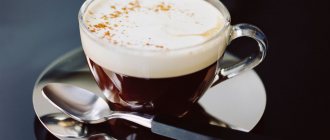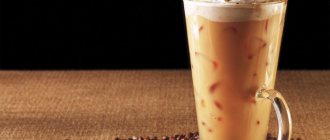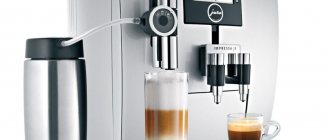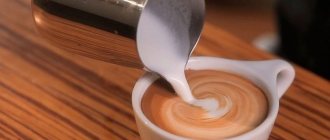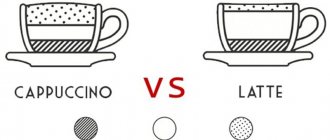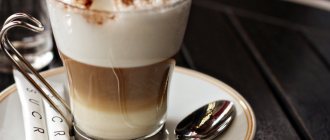Flat white - what kind of coffee is it?
This recipe was invented in New Zealand by barista Derek Townsend in the 90s. First, the drink gained great popularity among visitors to the DKD chain in Auckland, of which Derek was a co-owner, then its popularity spread throughout New Zealand and Australia, and from there the recipe penetrated into fast food establishments in the USA and Great Britain.
Translated, the name sounds like “flat white,” which well reflects the appearance of the drink, the surface of which is a uniform and glossy structure with a small bulge of foamed milk.
Characteristics of flat white coffee:
| Bean varieties | 100% Arabica |
| Roasting degree | Light or medium (Viennese) |
| Grinding | Fine or medium espresso |
| Ready coffee temperature | +67 ± 3 °C |
| Cooking time | 5 minutes |
| Portion output volume, ml | 180–190 ml (including foam) |
| Caffeine content (strength) | 100–116 mg (per serving) |
| Recommended intake (servings per day) | 1 |
| Maximum permissible norm (servings per day) | 2 |
| Calorie content | 62.6–69.2 kcal |
| Calories with sugar | 81.95–88.55 kcal |
In terms of taste, strength, volume served and ingredients, flat white coffee occupies a position between cappuccino and espresso. Unlike cappuccino, where the main taste is creamy, only offset by coffee, in this drink the coffee taste prevails due to the double shot of espresso in its composition.
The ratio of espresso and frothed milk here is within 1:2, which allows you to achieve the ideal flavor combination of creamy coffee taste and please those who do not like very strong espresso and too pronounced milky taste of cappuccino.
We can say that Derek’s creation has managed to fill an empty niche among fastidious coffee lovers. Flat whites are served in the same volume and in the same cups as cappuccino, so without testing they can only be distinguished by their appearance.
What it is
This drink filled an unoccupied niche, receiving the sympathy of those who wanted to make the taste of espresso softer and the taste of cappuccino livelier. The name of the drink comes from the English “flat white coffee”, which translates as “flat white”.
In fact, this is not easy, because the name refers to the form of presentation. The milk is frothed to a smooth structure so that the surface of the coffee is absolutely uniform and as smooth as possible. This is precisely what makes it different from cappuccino (after all, the drinks are served in identical cups and volumes, so they can be easily confused), because the foam is presented in the form of a small cone.
By the way, an interesting fact is that many coffee shops often serve a regular latte instead of a flat white, so look carefully at the foam. In a latte it is mostly brown and a little milky, while in a flat white the amount of white foam is in equal proportions with coffee-brown foam.
There is another theory about the origin of the name. It says that the male part of New Zealand refused to order coffee with added milk because they were convinced that it was not a man’s drink, so they came up with their own strong “flat white” for men.
Product requirements
To prepare the original flat white, a mixture of several varieties of Indian and Kenyan Arabica is used.
The beans should be medium roasted; for the best taste, they should be ground immediately before preparing the drink to a fine or medium grind.
the milk should be of medium fat content, but you can also use skim milk. To obtain foam of the required quality, you cannot use boiled milk. The optimal temperature before whipping is 60-70 degrees.
Water for brewing coffee should be soft and purified.
Proportions: the ratio of double espresso and milk is 1:2.
Sometimes honey is added to coffee instead of sugar and coconut or almond milk can be used instead of cow's milk.
Recipe
To prepare white coffee, experienced baristas usually take the best varieties of coffee, always medium roast, so that the drink does not taste bitter and does not have a heavy viscosity.
Watch a short video of making flat white coffee.
We will need the following ingredients:
- Finely ground coffee, medium roast (we recommend choosing a high-quality mixture of Arabica varieties, as this type of bean has a pleasant and mild taste).
- Milk 3-3.5% fat, heated to room temperature.
- Purified water (about 60ml).
The base of the drink is best made either in a special machine or in a coffee maker with an “espresso” mode. For one serving we will need two spoons of blend (mixture) and 60 ml of purified water, from which we will brew a double portion of espresso.
To make the coffee extraordinarily aromatic, we recommend additionally grinding the beans before brewing. After preparing doppio, be sure to pour it into a large porcelain bowl with thick walls (this is the type in which this coffee drink is usually served) and add sugar to taste. Then start preparing the foam, and then carefully combine it with the doppio.
Just remember that you should drink the drink after it has cooled down a little. It is then that you will be able to fully taste the real coffee taste and feel the pleasant milky aftertaste.
How to Serve and Drink Flat White Coffee
Flat white coffee is most often served in a cup with a volume of 200-250 milliliters, but from the point of view of traditions, this is not entirely correct. The prepared drink is poured so that its foam is flush with the edges of the cup.
The result should be a uniform, smooth white surface. Sugar is added to espresso at the preparation stage - before the coffee is mixed with milk.
Flat white does not need to be stirred: the beauty of it is that when you sip, the coffee passes through a layer of milk foam. Therefore, sugar is usually dissolved in the coffee base before adding milk. Nevertheless, the guest is offered a spoon and a sugar bowl or a sticker of sugar along with a cup of coffee.
The drink goes well with chocolate, shortbread and shortbread cookies, berry jellies and mousses. Flat white coffee is low in calories, but contains a lot of caffeine. It is better to limit yourself to 3-4 servings per week (one per day).
The drink is not stirred before drinking and the foam is not removed. This will allow you to fully experience its coffee taste, aroma and texture of the foam. Most often, flat white is drunk in the first half of the day.
Sweet dessert dishes are often ordered along with the drink, as they help highlight the taste of the coffee. These most often include tiramisu, muffins, panna cotta, and macaroons.
Taste of the drink
Flat white coffee will taste similar to cappuccino, but will be stronger and richer due to the double portion of espresso in its composition. Much will depend on the variety and roasting of the beans.
Strong roasting will give greater bitterness and richness. Also, the strength can vary depending on the amount of milk in the cup if the recipe deviates from the classic one.
Cooking technology
Initially, a proportion was invented that allows you to prepare real flat coffee.
- 60 ml espresso.
- 110 ml milk.
To prepare, you will need finely ground coffee. For one cup you need to take 2 teaspoons (approximately 14 grams) of coffee, 60 ml of water, 110 ml of milk and add sugar if desired.
First the espresso is brewed. The milk is heated to a temperature of 60 degrees. Half must be whipped to form a foam and carefully placed back into the pan.
Coffee is poured into a cup. Milk is gradually poured in. The goal is for the liquid part to create a homogeneous mass with espresso, and the other to settle as a flat foam on the drink itself.
In latte, the preparation technology, on the contrary, involves adding coffee to milk. In a cappuccino, everything is mixed, unlike a flat white, where mixing occurs independently.
In this drink, the technology produces equal amounts of white and brown foam. This makes it radically different from other types of coffee with milk.
More: What you need to know about raf coffee, how to prepare it
Difference from other coffee drinks
Since only espresso and frothed milk are used for preparation, a reasonable question arises - how does this recipe differ from other popular coffee and milkshakes.
Difference from latte and latte macchiato
It is often believed that a flat white differs from a latte only in volume, but this is not true. The latte contains virtually no whipped foam. It uses a large amount of heated milk and single espresso.
Latte macchiato consists of three layers: milk foam, coffee and milk. First, milk foam is prepared; it must not be completely whipped so that the milk remains. The espresso is then carefully added to create a beautiful, layered cocktail. Both of these drinks are usually served in transparent glasses.
Difference from cappuccino
Flat whites are usually served in a ceramic cup with thick walls, usually the same as cappuccino. However, the fundamental difference will be in the strength of the drinks.
“Flat White” will have a much more intense taste due to the double and sometimes even triple espresso in the composition. Both drinks are ideal for drawing coffee patterns on milk froth.
Difference from macchiato
To make a macchiato, use one shot of espresso and a little steamed milk. It is usually served in a cup with a volume of 60-80 ml.
Classic drinks
Cappuccino (33% espresso, 67% milk)
There are many myths about cappuccino. Let’s dispel one of them right away: this name has nothing to do with the hoods of monastic robes, or with the shorn top of the monks’ heads. The drink was invented in the 19th century in Vienna and was then called kapuzine . A little brewed coffee was mixed with milk or milk to obtain a brown tint - the color of the robes of the Capuchin monks. Basically, the name tells us about the strength of the drink.
Currently, in traditional Viennese coffee shops (old style) you can find a drink called Melange - well, it’s... almost a cappuccino

